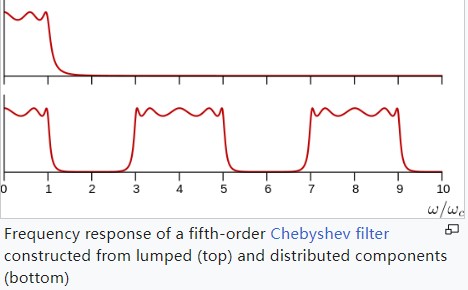Lumped-parameter design and Distributed-parameter design are common methods of radio frequency circuit design. This article will introduce the characteristics and differences between the two briefly.
Feature summary
Lumped circuit theory: circuit size is much smaller than the wavelength.
Distributed Circuit Theory: circuit size is comparable to wavelength.
Lumped parameter circuit
Lumped parameter circuit (or Lumped-element): In general circuit analysis, all parameters of the circuit, such as impedance, capacitive reactance, and inductive reactance, are concentrated at various points in space. On each component, the signal between each point is instantaneous. This idealized circuit model is called a lumped circuit.
The components involved are also called lumped parameter components, such as resistors, inductors, capacitors and conductive wires.
Low-frequency circuits correspond to lumped parameter circuits. For this type of circuit, the voltage and current at each position on the wire are the same.
The electromagnetic processes of the circuit components involved in are concentrated inside the components. There are conditions for using lumped circuits to approximate actual circuits. This condition is that the size of the actual circuit must be much smaller than the electromagnetic wavelength at which the circuit operates.
For lumped parameter circuits, Kirchhoff’s law uniquely determines structural constraints (also known as topological constraints, that is, the connection relationship between components determines the type of relationship that voltage and current must follow).
Distributed parameter circuit
Distributed parameter circuit (Distributed parameter) in a lumped parameter circuit, the actual circuit parameters are distributed and the parameter distribution must be considered. The circuit is called a distributed parameter circuit. It is also called a high-speed circuit, which means that the length of the transmission line and the working wavelength can be in- comparison, circuits need to be described by distributed parameter circuits. A typical distributed parameter circuit is a transmission line.
As the frequency increases, signal transmission is no longer voltage and current, but relies on electromagnetic field propagation, which is locked between the wire and the reference ground. Due to this high-frequency effect, if it is equivalent to a circuit, the voltage at each position on the wire is different (except for the period repetition point), and the current at each position is also different. This is the difference from a lumped parameter circuit.
In this case It is called a distributed parameter circuit and the wire is called a transmission line. Distributed parameter circuits also use lumped components, such as high-frequency inductors, capacitors, etc. However, it is required to pay attention to the self-resonant frequency when selecting.
At the same time, distributed parameter circuits also have a very important concept – Characteristic Impedance, which is the ratio of equivalent voltage to current at a certain position on the transmission line. Theoretically, the characteristic impedance is a constant, and as long as the source and load impedances match, there will be no reflection. Characteristic impedance is not a loss resistance, but an attribute of the transmission line, which can characterize the reflection of the signal on the transmission line.
Distributed Circuit Analysis
To help understanding, the distributed circuit analysis method can be understood as the differential of the lumped circuit analysis method.
For example, to analyze a wire, we divide it into a very small line-element. When it is cut into infinitesimal line-elements, the wavelength is much larger than the line-element size. In this case, Kirchhoff’s voltage and current law can be used to analyze, and it is possible to use known things to deduce unknown things.
Lumped circuit theory, such as Ohm’s law and Kirchhoff’s voltage and current law, are applied on the premise that the circuit size is much smaller than the wavelength. When the circuit size and wavelength are comparable, we should consider a more complete theory – Distributed Circuit Analysis Law.
It can be said that lumped circuit theory is a special case of distributed circuit theory and is an approximation made for simple calculation. But even with the distributed circuit analysis method, sometimes the model inside also needs to be approximated and simplified.
Design and application:
Radio frequency and microwave circuits are basically distributed parameter circuits. But in the L, S, C and other bands, the impedance matching of active circuits can still be achieved using lumped components such as high-frequency inductors and capacitors.
In some VHF frequency bands, both lumped parameter and distributed parameter circuit principles may be used for design, but how to better design the circuit will depend on the experiences of the engineers and the actual needs of the customer.
 Remark: picture from internet
Remark: picture from internet



